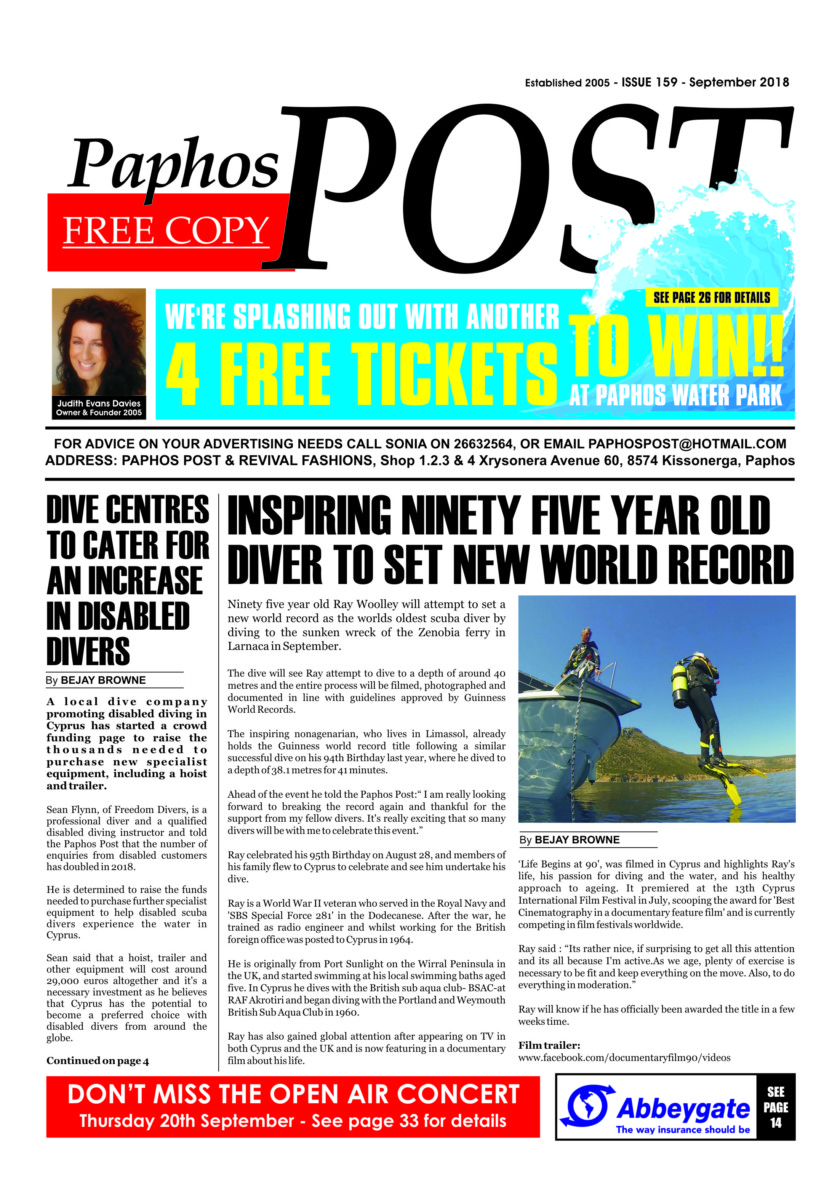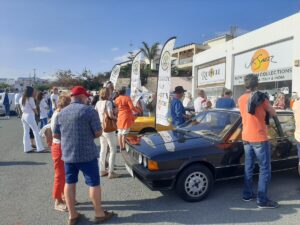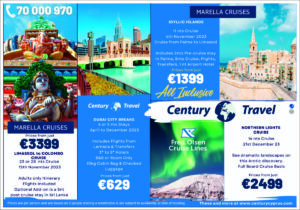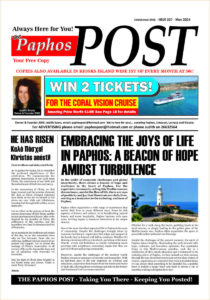New website to promote Paphos district
By Bejay Browne
The Paphos regional board of tourism has launched a new comprehensive website as part of a wider campaign utilising technology and upgraded literature to help to promote the entire district.
“This is one of the actions to renew the promotional material of Paphos. It is very necessary to use new technology to meet the changing needs of the user,” Nasos Hadjigeorgiou, the head of the Paphos regional board of tourism, told the Paphos Post.
The site, he added, is dynamic and responsive and was developed by a Paphos based company using the latest technology.
It is expected that the site will garner thousands of unique visitors a year, as the previous one, which was dated and far harder to navigate, welcomed over 170,000 unique overseas users every year.
The site contains stunning photographs of all sorts of areas of the wider district and contains useful information about the area: what to see, where to go, where to stay, news and events, and the ‘highlights’. These includes: Paphos old town, the medieval castle, sea caves, Avacas Gorge, Baths of Aphrodite, villages, fascinating fauna, mouflon, boat trips and more.
“Visitors can see what is available and it gives them an opportunity to understand Paphos and what there is to enjoy in all of the area of Paphos district.”
An accommodation section includes everything from luxury beach hotels and resorts for a city and spa break, to holiday villages and authentic back-to-basics family-run establishments.
All sorts of upcoming events are also regularly added to the website.
“There is emphasis on rural areas, the beautiful nature we have and the cultural aspects of Paphos,” he said.
The new website, along with a video of Paphos that was launched earlier in the year and newly designed promo material, means that the promotion of Paphos tourism has now been upgraded significantly, he said.
www.visitpafos.org.cy
Conservation efforts see rise in turtle nest numbers
By Bejay Browne
The number of turtle nests this year has increased over last year and stands at around 1,600 so far, according to the founder and co-head of the turtle conservation programme, Andreas Demetropoulos.
The number is still growing and has already exceeds last year’s 1,100.
This is due to the work undertaken by conservationists 20 to 30 years ago, he said, as this is how long it takes the endangered Loggerhead and Green turtle (Cheloniamydas) to reproduce.
When the programme started, there were just 300 nests.
“The best year was three years ago, in 2016, with 1,800 nests,” Demetropoulos said. “The numbers fluctuate but they are still going up.”
One of the reasons for the success is that the nesting grounds are now protected from foxes, as cages are placed around them.
Also, two large areas which are the habitat of turtles- Lara and Toxeftra beaches- have been protected since 1989 and are designated Natura 2000 sites. Previously, visitors would confuse and disturb the turtles by camping and lighting fires.
However, the rise in tourism and the threat of building permits for hotels and other buildings in the region may bring the numbers down in future, the conservationists fear.
The fisheries department and other organisations are working to ensure the survival of the species.
In March this year, a 24-hour hotline was launched to report injured, sick, or dead sea turtles by the Oceanic Institute of the University of Cyprus to help improve their management and protection.
Injured turtles are taken to the marine research centre of Cyprus, where they are treated and then released back into the sea.
Green turtles reproduce almost exclusively in Cyprus and Turkey and there are only around 1,500 female Green turtles that lay eggs in both countries.
The Loggerhead or Caretta caretta also breeds in Greece and in smaller numbers in other Mediterranean countries, the number of females is around 6,000.
Both are protected by the European Union’s habitat directive.
The hotline number for reporting dead or injured marine turtles is : 96 952929
Dive centres to cater for increase in disabled divers
By Bejay Browne
A local dive company promoting disabled diving in Cyprus has started a crowd funding page to raise the thousands needed to purchase new specialist equipment, including a hoist and trailer.
Sean Flynn, of Freedom Divers, is a professional diver and a qualified disabled diving instructor and told the Paphos Post that the number of enquiries from disabled customers has doubled in 2018.
He is determined to raise the funds needed to purchase further specialist equipment to help disabled scuba divers experience the water in Cyprus.
Sean said that a hoist, trailer and other equipment will cost around 29,000 euros altogether and it’s a necessary investment as he believes that Cyprus has the potential to become a preferred choice with disabled divers from around the globe.
“It might not sound like a lot but we have 12 disabled divers this year and many more enquiries for next year, as it takes longer to plan holidays and to ensure their needs are covered,” he said.
A portable pop up changing room, a beach wheelchair, a pro lift sling and an underwater scooter are all on the list of items needed.
Sean has already spent around eight to nine thousand euros on equipment, but would ideally next like to purchase a mobile pool hoist that would enable him to get would-be divers in and out of swimming pools at holiday homes and hotels. Pool training is what every diver must go through before heading out into the sea, he said.
“I just can’t afford to buy anymore equipment and I would really like to be able to help them,” he said.
Sean said that most people are able to dive, no matter what their disability is, and although most other dive centres in Cyprus that take disabled people charge them more as the costs are higher, he doesn’t. His aim is to help divers feel the freedom of weightlessness in the water.
“For us, It’s not about the money. I only cover my costs on dives with disabled people and that’s not why I do it.
To see the joy on their face and to be able to give them an experience that they never thought was possible is a really amazing feeling. It gives them such pleasure,” he said.
On such dives, Sean employers a minimum of a second experienced diver, and in some cases this will be more, to ensure the safety of the disabled diver, this pushes up the costs, he said, but these are not passed onto his customers.
Sean is a fully qualified PADI instructor (Professional Association of Diving Instructors) and also as a disabled diving instructor with DDI – Disabled Divers International. He recently took a Russian diver into the water to dive in Limassol using a new ‘Seatrac’ motorised ramp which has been installed at a beach there.
He explained that the young Russian holiday maker broke his neck cliff diving a few years previously and was left paralysed from the neck down.
As and more and more disabled people are making enquiries, Sean said that other dive centres have offered their services, helping with tanks, equipment and staff.
For further information: www.freedomdiverscyprus.com
Inspiring ninety five year old diver to set new world record
By Bejay Browne
Ninety five year old Ray Woolley will attempt to set a new world record as the worlds oldest scuba diver by diving to the sunken wreck of the Zenobia ferry in Larnaca in September.
The dive will see Ray attempt to dive to a depth of around 40 metres and the entire process will be filmed, photographed and documented in line with guidelines approved by Guinness World Records.
The inspiring nonagenarian, who lives in Limassol, already holds the Guinness world record title following a similar successful dive on his 94th Birthday last year, where he dived to a depth of 38.1 metres for 41 minutes.
Ahead of the event he told the Paphos Post:“ I am really looking forward to breaking the record again and thankful for the support from my fellow divers. It’s really exciting that so many divers will be with me to celebrate this event.”
Ray celebrated his 95th Birthday on August 28, and members of his family flew to Cyprus to celebrate and see him undertake his dive.
Ray is a World War II veteran who served in the Royal Navy and ‘SBS Special Force 281’ in the Dodecanese. After the war, he trained as radio engineer and whilst working for the British foreign office was posted to Cyprus in 1964.
He is originally from Port Sunlight on the Wirral Peninsula in the UK, and started swimming at his local swimming baths aged five. In Cyprus he dives with the British sub aqua club- BSAC-at RAF Akrotiri and began diving with the Portland and Weymouth British Sub Aqua Club in 1960.
Ray has also gained global attention after appearing on TV in both Cyprus and the UK and is now featuring in a documentary film about his life. ‘Life Begins at 90’, was filmed in Cyprus and highlights Ray’s life, his passion for diving and the water, and his healthy approach to ageing. It premiered at the 13th Cyprus International Film Festival in July, scooping the award for ‘Best Cinematography in a documentary feature film’ and is currently competing in film festivals worldwide.
Ray said : “Its rather nice, if surprising to get all this attention and its all because I’m active. As we age, plenty of exercise is necessary to be fit and keep everything on the move. Also, to do everything in moderation.”
Ray will know if he has officially been awarded the title in a few weeks time.
Film trailer: www.facebook.com/documentaryfilm90/videos/443791259383879/
VR app recreates stunning ancient Paphos theatre
By Bejay Browne
A new virtual reality mobile application, called Lithodomos VR, which allows users to experience the majesty of the theatre in Kato Paphos during its heyday in 150 AD is now available to download.
“The availability of the app for download on iTunes and Google Play now gives people a chance to view the ancient theatre from their own home (so long as they have a VR headset),” said Dr Craig Barker, one of the archaeologists involved with the project, speaking to the Paphos Post from Australia.
University of Sydney archaeologists have joined forces with Melbourne based digital technology firm Lithodomos VR (LVR) to create a virtual reality mobile appl ‘Lithodomos VR’ that showcases a 360-degree view of the building’s grand Roman façade, marble columns, imperial statues and painted entranceways.
LVR is an Australian start-up company which specialise in Virtual Reality (VR) reconstructions of the ancient Mediterranean archaeological sites.
Barker has used the app at the heritage listed site when giving Cypriot school children tours of the archaeological site, as well as with school groups visiting the University’s Nicholson Museum.
“We have brought history to life and used modern technology to examine a 2,000-year-old building,” he said.
Only the foundations of the Paphos theatre, used for performance and spectacle for more than 600 years, remain today.
For the last 20 years Barker has led the university’s efforts to uncover Nea Paphos. He said that the collaboration was a natural fit for the Paphos Theatre Archaeological Project. Barker and a number of colleagues, university students and volunteers, have uncovered paved Roman roads, an ancient nymphaeum (water fountain) and the semi-circular theatre over the years.
“There have been some, but limited, reconstructions of ancient sites in Cyprus in this format, but the Paphos theatre lent itself well for a 3D VR experience. The benefits for us as an archaeological project is it allows people to visualise what the theatre would have looked like long after its destruction.”
Dr Despo Pilides, curator of the Antiquities Department said that they encourage the use of technology in such instances where it promotes the value of archaeological sites and museums.
“We welcome new ideas, especially those that are educational. By engaging adults and children and interesting them, this is one of the best ways to protect culture and heritage,” she said.
Barker noted that both VR and AR are increasingly being used in archaeology as a means of visualising the past, adding that the archaeologists are now part of a big trend in using new technology to study old sites.
“Cyprus is perfect for this type of technological use.”
The VR headset and app was first unveiled at an art exhibition for Pafos2017 in October and a headset was available for visitors. The team also used it on site during their excavations at the end of last year, for visitors – including visiting school students – to learn more about what the site probably looked like.
The theatre of Paphos was used for over six centuries (c. 300 BC – 365 AD) and technologies such as these enable people to understand how much the building has changed over time, and how different the surviving ruins looked from the ‘actual’ theatre, he said
By downloading the app and wearing the headset, viewers are able to see the ancient theatre from three different views – a 360 degree angle view from the upper seating, and two views from the ancient orchestra – which gives viewers an idea of what the ancient stage and the seating looked like. The theatre was 100m in diameter and could seat over 8000 people at this point in its history, so it’s impressive, he said.
“We have used it a lot for teaching school students in Australia which is very exciting and everyone is thrilled by the experience, but we do have to watch that people don’t walk into things, thinking they are actually within the 3D space of the ancient theatre.”
Barker said that the Australian team is currently working on an academic publication of their findings so far and aim to return to the site in September-October 2019.
“We are pleased to be welcomed by our friends and supporters in Paphos each time we dig at the site, and there are many people in Australia who now regard Paphos as their second home.”
LVR made its first breakthrough in early 2017 with modest funding and has since mushroomed, boasting, museums, tourism operators and universities from all over the world as clients, and have partners at more than 50 sites in 15 countries.











